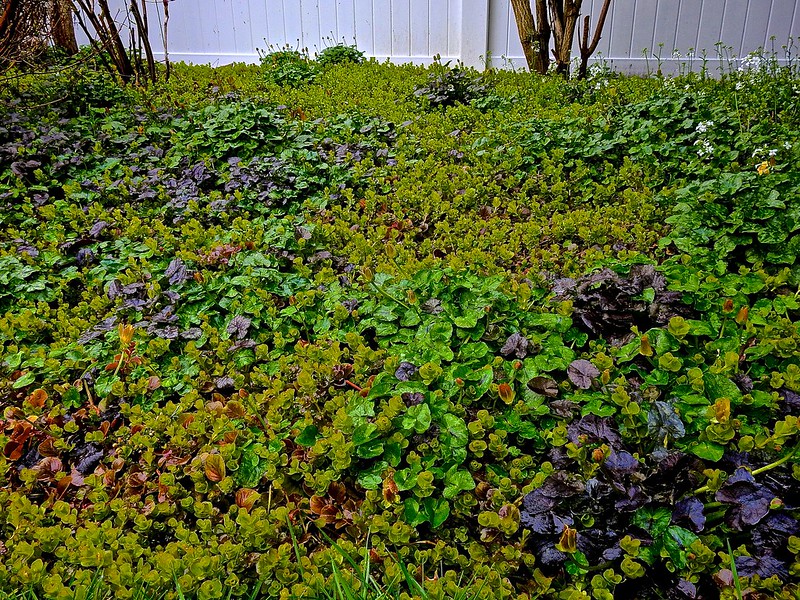Tired of Traditional Turf? Try a Grass Alternative
BY MAX MUSTERMANN | OCTOBER 15TH, 2019 | HOME & GARDEN, LANDSCAPING, LAWN CARETraditional lawns are part of the American dream — an ocean of green covering nearly 2% of our nation’s area. But at what cost? Americans view the hassle of mowing, fertilizing, irrigation, and pest control our lawns demand as the price we pay for flawless turfgrass. The net effect is a bit grim.
Cristina Milesi, a NASA researcher who studies lawn area, says, “I estimate there are three times more acres of lawns in the U.S. than irrigated corn.” Her figures reveal turfgrass is the largest crop in America. “Each family may have only a small lawn,” she explains, “but once you add them all up, they have a big impact.”
Grass is needy. It needs a mower to manage its length and an edger to tidy its margins. It thrives in full sun and struggles in shady areas. It hungers for fertilizer and thirsts for water. In short, maintaining a grass lawn means spending a lot of time and money on lawn care.
There are lawn alternatives that are low-maintenance and need less water than a traditional lawn. Here’s a selection of lawn replacements that can save you time and make your yard more eco-friendly.
Native Grasses
Turfgrass isn’t all bad: It absorbs carbon dioxide and helps prevent erosion. But the non-native varieties used in the traditional lawn take large volumes of water and fertilizer. Native grasses thrive on poor soil, are drought-tolerant, and don’t mind partial shade. The best part? They require little maintenance.
The most common native is buffalo grass (pictured above), a bunch-type grass that once dominated the Plains. Others include bluestem, blue grama and switchgrass. Contact your local county extension agent to see what the most common varieties or blends do best in your area.
If your goal is to reduce lawn maintenance, consider a product like No-Mow-Grass. There are two blends sold commercially under the No-Mow brand. One is a fescue mix for Northern areas where it freezes, and the other is a buffalo grass mix for hot, dry Southern climes. Despite the name, No-Mow-Grass needs mowing once a year in late spring or fall. Like any turf grass that sees heavy foot traffic, No-Mow lawns benefit from a core aeration every couple of years.
Ornamental Alternatives

- Garden beds or borders reduce the size of your lawn without eliminating it. Plant drought-resistant native plants to attract pollinators.
- Rock gardens showcase drought-resistant succulents, cacti, wildflowers, and ornamental grasses in beds.
- Native meadows offer a low-maintenance and natural way to enjoy your landscape
- Ground covers like creeping thyme or dichondra can replace turfgrass in areas that don’t get much sun.
- Moss can be cultivated as a grass alternative under a tree canopy where sunlight is scarce.
- Creeping jenny, while considered a noxious weed, can make an excellent ground cover beneath trees. It does need a solid border containing it.
Non-Plant Alternatives
Not all grass alternatives are green. Using mulch, gravel, or even artificial turf to cover large areas of the yard can be aesthetically pleasing and are obviously shade and drought tolerant as can be. The jury is still out on whether artificial grass is a good alternative to turfgrass. Mulch is a fine addition to garden and flower beds because it helps to control weeds, retains soil moisture, and breaks down over time, adding nutrients to the soil.
White Clover Lawn
Offering compact, thick green growth, Dutch white clover is a perfect lawn replacement. Its root system generates nitrogen, reducing the need for fertilizing. You can achieve a more drought-tolerant lawn that requires less mowing by encouraging the growth of existing white clover patches. A mixed turfgrass and clover lawn can take heavy foot traffic better than a solid clover lawn.
7 Steps to replace your lawn with white clover
- Mow your lawn close to the ground (scalp it), and rake out the thatch from the last growing season.
- Aerate, especially if it’s been over a year since you last loosened the soil.
- Mix white clover seed with sand or soil (they are very fine) and broadcast 6-8 ounces of seed per 1,000 feet of yard. You may want to use a broadcast spreader for even distribution.
- Water deeply after spreading seed, and water at regular intervals for a few weeks until the clover is established.
- Mow in the middle of summer to remove the white flowers once they’re spent.
- Never use fertilizer or herbicide on a clover lawn.
- Re-seed every two to three years if the clover is looking a bit thin. You’ll see new growth within a few weeks.
The bottom line? There’s no reason to support a needy front lawn when so many shade-loving lawn replacements exist. Find your groove, make your changes, and pat yourself on the back for doing your part to make the world a little greener.
Main image credit: “Buffalo grass” by CAJC: in the PNW is licensed under CC BY-SA 2.0